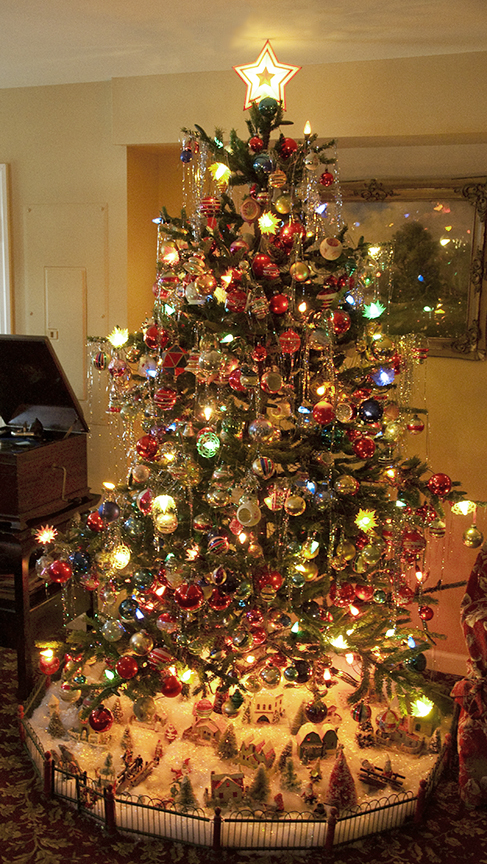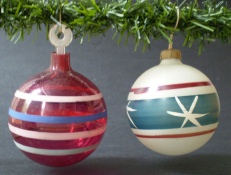 Nearly all of the early glass ornaments that hung on American Christmas trees were imported from Europe. However, beginning with the British Blockade of 1939, no further ornaments were imported until after World War II. The Corning Glass Company in New York stepped in and, by converting a light bulb making machine to one that made ornaments, began producing ornaments for the Christmas of 1939 and became the prime manufacturer of American ornaments.
Nearly all of the early glass ornaments that hung on American Christmas trees were imported from Europe. However, beginning with the British Blockade of 1939, no further ornaments were imported until after World War II. The Corning Glass Company in New York stepped in and, by converting a light bulb making machine to one that made ornaments, began producing ornaments for the Christmas of 1939 and became the prime manufacturer of American ornaments.
 World War II created a severe shortage of the materials necessary to manufacture Christmas ornaments, especially for silver and other metals, which were needed for the war effort.
World War II created a severe shortage of the materials necessary to manufacture Christmas ornaments, especially for silver and other metals, which were needed for the war effort.
There is a direct correlation between each year of the war and the appearance of our ornaments. The first wartime ornaments were made from glass, but were not silvered on the inside. That made them appear very dull, so very quickly they were decorated with a sprig of tinsel on the inside to make them sparkle. As the war effort intensified, even this practice was abandoned because every piece of metal was needed. Even metal caps disappeared, to be replaced with cardboard or paper tops, and eventually, the clear glass ball had only small stripes of paint for its decoration. Red was the favorite color during the 1940s, with silver and blue tying for second, and green coming in third. Shown are a clear, circa 1945 transparent ball with painted stripes and a cardboard hanger, and an earlier pink glass ball with stenciled holly leaves and a USA metal cap.
As the 1950s began, we were again importing a tremendous variety of European glass ornaments, and they were coming from several different countries. Indents were very popular, and solid color balls were being used on aluminum trees. By the mid-1950s, the shapes became even more fancy. Shiny Brite ornaments – always a staple of ornament manufacturing, continued to be made into the mid-1950s, and then disappeared. The same colors, red, silver, blue, and green, continued to be favorites through the 1950s. Pictured (right) is a tree packed with vintage Shiny Brite ornaments, lighted with C6-size vintage lights with NOMA tin reflectors, topped with a 1950 NOMA lighted star. AChristmas Village or “putz” scene adds a magical foundation to the this beautiful tree.
Many of us probably remember these glass ornaments from the ’40s and ’50s as part of our childhood. They take us back in our minds and hearts to a more uncomplicated, innocent time. Like a smell or a song, one look at a special ornament can bring all those memories back again, and reconnect us to one another and the past.

